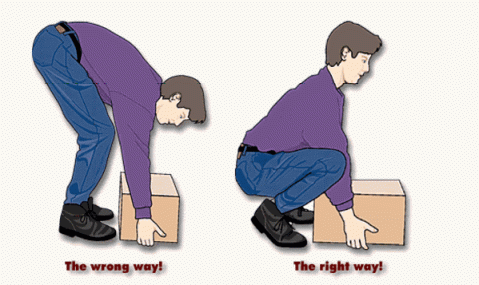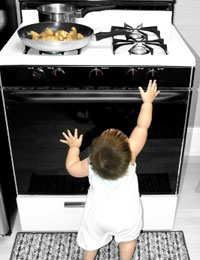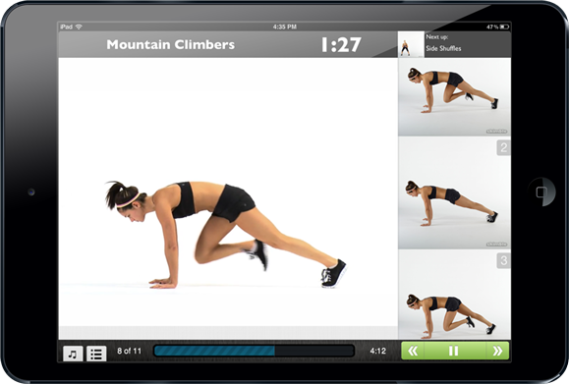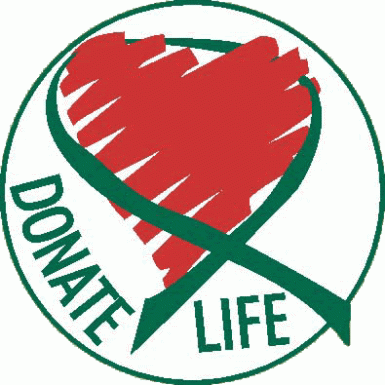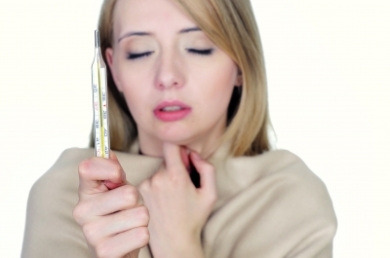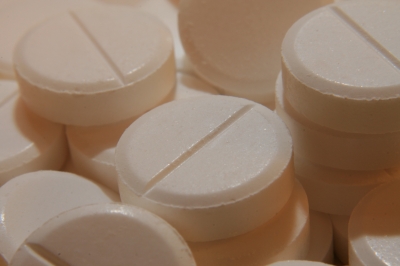Lift with Care to Limit Back Pain
Injuries caused by poor lifting and handling practices can cause major back pain. To avoid these unpleasant and often inhibiting injuries, remember these safe lifting and carrying recommendations while you are doing chores around the house.
Safe Lifting and Handling Techniques
Lifting from ground level:
- Get as close as possible to the load and bend down at your knees; not your back.
- Get a good grip on the object and test its weight.
- Keep the load close to your body and lift up with your legs.
- Be aware of your balance and what part of your body is doing the work – it should be your legs.
Lifting from a shelf, desk or counter:
- Pull the load close to your body and test its weight.
- Shift the weight of the load to your legs by keeping it close.
Lifting from overhead:
- Make certain you are standing on a stable surface before you attempt to lift.
- Test the load to be sure that you can lift it safely.
- Take the object off of the shelf carefully and maintain your balance.
- Maintain control of the load, and bring it down to waist level.
Carrying heavy loads around the house:
- Look ahead to make certain your path is clear.
- Avoid stairs if possible. If you must use the stairs, hold the banister or wall to maintain your balance.
- Have someone else hold doors and gates open for you.
- Change direction by moving your feet, not your hips.
- Keep your shoulders, hips and feet pointing in the same direction.
- Never twist at the waist while you are carrying something heavy.
- Always set the load down if it becomes too heavy to avoid straining a muscle.
Setting down heavy loads:
- Bend at your knees, not your waist and set down the corner of the object closest to you first.
- Remember to keep your fingers out from under the load as you set it down.
Safe lifting and carrying techniques can help you avoid strains, sprains and other painful injuries. Whatever the task at hand, make sure to ask for help from a family member when the load is too heavy for you to handle on your own!
For more information on avoiding back injuries and questions regarding your insurance, contact your agent.
Head Out to Sea Without Injury
Water sports, relaxing in the sun and splashing in the water are great ways to make memories with family and friends. Sea lovers must be careful near the marina and dock, though, to assure that their getaways are safe ones. If you are hitting the opening waters this season, don’t forget these safety tips!
Dock Safety
- Use forward and reverse at an idle speed when docking and moving your boat near the marina.
- Have bumpers, mooring lines and boat hooks ready before docking.
- Keep all body parts in the boat until you have come to a complete stop.
- Tie the line that holds the boat against the wind first when docking.
- Dock at a marina that has stand pipes, fire extinguishers, good lighting, surveillance cameras and security measures in place.
- Always wear personal flotation devices when on the water, especially those than cannot swim and children.
- Do not swim near a marina since boaters cannot see you when they are trying to dock.
- Wear non-slip shoes on the boat and dock.
- When leaving your boat, turn off any portable heaters on board.
- Keep your boat in good condition with all equipment meeting safety standards established in your area.
- Assure that the marina has the proper power voltage for your boat.
- Add fuel to portable tanks on the dock only; never on the deck of your boat.
To avoid a potential fire onboard, inspect fuel hoses and containers on a regular basis to prevent the escaping vapors from going into bilges. Also check the wiring and all appliances on deck for damage frequently.
As a safety precaution, keep fire extinguishers on deck and fit smoke detectors to the cabin.
For more information regarding boat safety and your insurance, contact your agent.
Keeping Babies Safe at Home
Many new parents worry about the dangers their little ones will face outside of the home; however, some of the greatest threats are lurking in the nursery, the kitchen and the bathroom within their homes. In fact, children between the ages of one and four are more likely to get injured by fire, burns, choking, poisoning or falling at home than by violence from a stranger.
To keep your little one safe as they grow, implement these safety precautions in your home:
Baby Safety Recommendations
Choking Prevention
- Put babies to sleep on their backs and keep toys, pillows and excess blankets out of the crib.
- Do not hang ribbons, strings or any items that can be grabbed over a crib.
- Do not give children toys that are not age-appropriate by always reading the manufacturer’s packaging to make sure that it is suitable for their age and ability level.
- Cut the loops of window blind cords into two pieces and place them out of your baby’s reach.
- Monitor your baby while they are eating, drinking or teething. Make sure he/she is upright and not crying when feeding solid foods.
- Mash or grind foods so they are soft enough to gum and swallow.
- Do not feed children peanut butter, popcorn, raw carrots, nuts, grapes or uncooked peas before age three because children often do not chew food before they swallow it.
Fall Prevention:
- Use safety gates at the base and top of staircases.
- Secure children with straps in high chairs, changing tables and strollers.
Poisoning:
- Remove medicines and medical supplies from easily accessible places around the house. Place these items out of your baby’s reach.
- Place cleaning products, alcohol and other poisons in a cabinet with a child safety lock.
- Identify household items that may be toxic to young children. (ex: Iron pills are the leading killer of children under age six).
Water Hazards:
- Place locks on your toilet lids and bathroom doors.
- Do not leave standing water in buckets for your child to access. Small children can drown in as little as two inches of liquid if they fall in.
- Set your water heater to less than 120°F to prevent accidental scalding, and use a water thermometer to test bath water before placing your child in the tub.
Keep your little ones safe every day of their young lives by keeping a close eye on them. For more information regarding baby safety, contact your pediatrician. For more information regarding home insurance, contact your agent.
Five Spring / Summer Activities to Get You Fit While Having Fun
Looking to mix up your boring fitness routine? Consider swapping your usual run or workout at the gym with one of the following outdoor summer activities that will make you break a sweat while still having fun.
Beach volleyball: If you’re headed to the beach, try starting a pickup game of volleyball, or consider joining a rec league team. A 155-pound person can burn up to 550 calories in 60 minutes!
Inline skating: For a fun way to burn 490 calories in an hour, dust off your old inline skates and take them for a spin. Be sure to wear all the necessary protective gear when you do.
Ultimate Frisbee: A combination of Frisbee and football, this game is a great way to sheds pounds with some friends. A 155- pound person can spend 240 calories in just an hour.
Tennis: If you want a great workout, grab a friend for a game of tennis. During an hour long match you’ll burn 560 calories.
Swimming: On those especially hot days, head to the nearest body of water and go for a swim. Doing laps for an hour will have you burning up to 560 calories!
For more information on life insurance, contact your agent.
Seasonal Allergies: Spring
Mold growth blooms inside and outside with spring rains. As flowers, trees, weeds and grasses begin to blossom, allergies will follow.
Spring-cleaning activities can stir up dust mites, so be sure to:
- Wash your bedding every week in hot water to help keep pollen under control.
- Wash your hair before going to bed, since pollen can accumulate in your hair.
- Wear a mask and gloves when cleaning, vacuuming or painting to limit dust and chemical inhalation and skin exposure.
- Vacuum twice a week.
- Limit the number of throw rugs in your home to reduce dust and mold.
- Make sure the rugs you do have are washable.
- Change air conditioning and heating air filters often.
For more information on preventing spring allergies from taking over, contact your doctor. For more information regarding your insurance, contact your agent.
High Blood Pressure
Each time the heart beats, it pumps out blood into the arteries. Blood pressure is highest when the heart beats (called systolic pressure) and lowest when at rest (diastolic pressure). This is why blood pressure is always given as two numbers, such as 120/80, which is considered the normal range. Once the level reaches 140/90 or above, it is considered high blood pressure. With this condition, the heart and arteries work harder, and the chances of a stroke, heart attack or kidney problems are greater.
Causes and Risk Factors
No single specific cause has been identified in people with high blood pressure, but research is ongoing. In some people, it is the result of another medical problem or medication. When the cause is known, this is called secondary high blood pressure. Research has shown that the following factors put one more at risk for high blood pressure:
- Obesity
- Being African-American
- If male, being over age 45; if female, being over age 55
- A family history
- Having prehypertension (blood pressure in the 120-139/80-89 range)
- Excessive salt and/or alcohol consumption
- Not enough potassium in the diet
- Being physically inactive
- Having ongoing stress
- Smoking
- If female, taking certain oral contraceptives
Symptoms
Those with high blood pressure may have it for years without knowing, due to its lack of symptoms. The only way to find out is to have routine blood pressure checks during every visit to the doctor.
The Importance of Treatment
The first and best course of action when high blood pressure is discovered is to change eating and exercise habits. However, sometimes even when a person makes healthy changes, blood pressure remains high. In that case, a physician will most likely prescribe a blood pressure medication. If left untreated, high blood pressure can cause:
- Enlarging of the heart, which leads to heart failure
- Aneurysms in the arteries of the heart, brain, legs, intestines or spleen
- Narrowing of the blood vessels in the kidney, leading to kidney failure
- Hardening of the arteries, which can cause a heart attack, stroke or kidney failure
- Blood vessels bursting in the eyes
Prevention
High blood pressure can easily be prevented. Some of the best ways to avoid the condition include:
- Limiting salt, fats and alcohol
- Eating healthy foods such as fruits, vegetables, whole grains and low-fat dairy products
- Maintaining a healthy weight
- Being physically active
- Quitting smoking
Did You Know..?
Those with high blood pressure often exhibit few or no symptoms, which is why the condition is frequently referred to as the “silent killer.” For more information on controlling blood pressure, contact your physician. For more information regarding life insurance, contact your agent.
Is Your Workout Tech-savvy?
While technology is not a mandatory addition to your workout, many individuals find it useful and even motivating. Music players are only the tip of the iceberg—whatever your fitness regime, there’s probably some sort of device or app for it.
If you’re looking to make your solo workout more exciting and interactive, fitness gaming, or active video games, might be for you. From yoga to boxing to tennis, there are many types of fitness video games that really do make you break a sweat.
For smartphone lovers, there are apps that can remind you it’s time to exercise, and track distance travelled, your course and workout time—some of these apps are even available to download for free.
Those numeric-minded individuals looking for measurable results may find pedometers, heart rate monitors and multi-purpose tools useful. From measuring sleep quality to tracking the number of calories burned, these tools record workout and daily activity levels.
If your workout routine hits a bump in the road, try giving it a technological twist—you may find it’s just what you need to boost motivation and get back on track.
For more information regarding online tools to help keep you active, contact your mobile phone provider. For more information regarding life insurance, contact your agent.
Organ Donation
More than 114,000 Americans are currently on the waiting list for an organ donation, but last year only 14,147 organs were donated.
There are two systems for organ donation: opt-in and opt-out. Most European countries operate on an opt-out system, which assumes that a person is willing to donate their organs, though individuals are free to opt-out.
The United States uses an opt-in system for organ donation, so people are required to designate in advance that they are willing to donate their organs. If a person is not a registered donor, that person’s organs cannot be given to people on the organ donor list.
A single organ donor can save up to eight lives, so consider registering as a donor at www.organdonor.gov.
DID YOU KNOW
More than 80 percent of people on the organ donation list are waiting for a kidney, but most children under the age of 5 on the list are waiting for a liver transplant.
For more information regarding organ donation and how you can get involved, contact your physician. For more information regarding your life insurance, contact your agent.
Feeling Under the Weather?
Tips for determining when to take the day off
It happens to the best of us, you feel a little sluggish when going to bed, only to wake up with a fever, sore throat and headache. You’re disappointed that you don’t feel well and are conflicted about whether to stay home from work. But you have a deadline on a big project, and so many other tasks require your attention.
No need to fret; a bit of practical common sense can lead you to make the right decision regarding whether to take the day off. Consider the following stipulations when determining if you need to spend the day in bed with some soup and a good book.
- Are you able to successfully complete your job duties? If you are too ill, you will not be able to accomplish what you need to throughout the day. Consider staying home until you feel well enough to perform at your best.
- Is your illness contagious? If you have been diagnosed with a viral or bacterial illness, you can infect your coworkers. Consider staying home to contain your illness until you are no longer contagious.
- Will a little rest do you some good? If you run yourself ragged when you are already feeling under the weather, you will only make your condition worse. Consider staying home until your body has a chance to fight off some of the illness.
- How will medications interfere with your abilities? Some medications, such as opiates, can cause drowsiness, dizziness and other side effects that make driving and operating heavy machinery dangerous. If you are taking medications for your illness that could infringe on your ability to drive to work and safely complete job tasks, stay at home until you are no longer them.
Other Issues to Consider
- The common cold and flu are the most contagious within the first two days after symptoms begin.
- Resting for a day or two will aid in reducing a fever over 100.3 degrees, especially when it is accompanied by muscles ache, runny nose, headache, sore throat, fatigue and a cough.
- Sitting at a desk for long hours can be just as strenuous on your body as the hard labor of bending and lifting.
Did You Know…?
The common cold and flu are the most contagious when individuals first notice symptoms because of the intensity of the virus. However, others can be infected for several days or even a week after symptoms become evident. For any more suggestions on keeping yourself healthy, contact your life insurance agent.
Daily Aspirin Therapy for Heart Health
Heart disease is a concern for many Americans and is the leading killer of women in the U.S. Along with a healthy diet and exercise, those at risk of a heart attack or stroke can take another precaution to reduce their risks – a daily dose of aspirin.
According to the Mayo Foundation for Medical Education and Research, taking an aspirin daily can actually lower the risk of heart attack and stroke, as it interferes with the body’s blood clotting action.
As blood clots within the vessels that supply blood to your heart and brain, it can block arteries that are already narrowed due to the buildup of fatty deposits. When this occurs, blood cannot flow to the heart and brain successfully, which can lead to a heart attack or stroke. However, by taking aspirin on a regular basis, you can reduce clotting and potentially prevent a heart attack or stroke.
Is Aspirin Therapy Right for Me?
Taking a daily dose of aspirin is not right for everyone and it is ultimately up to you and your doctor to determine if this therapy will benefit your current health condition. Those who will typically benefit from daily aspirin therapy are:
- Smokers
- Those with high blood pressure
- People with a total cholesterol level of 240 mg/dL or higher
- Those with a low-density lipoprotein (“bad” cholesterol) level of 130 mg/dL or higher
- Those who lack regular physical activity
- Diabetics
- People experiencing lots of stress
- Men who consume more than two alcoholic drinks per day or women who consume more than one alcoholic drink per day
- People with a family history of heart attack or stroke
Though you may be afflicted with some of these risk factors, daily aspirin therapy may not be for you if you have any of these conditions:
- Suffering from a bleeding or clotting disorder
- Asthma
- Stomach ulcers
- Heart failure
- Taking certain medications that may increase your chance of bleeding
Dosage
There is no uniform aspirin dosage that suits all patients with heart disease risk factors. Some patients benefit from 75 mg, which is less than one baby aspirin, while others benefit from 325 mg, or the potency of one regular aspirin.
Side Effects
There are several side effects of taking daily aspirin therapy that you should discuss with your doctor before beginning this regime. They include:
- Hemorrhagic stroke (bleeding stroke)
- Gastrointestinal bleeding (development of a stomach ulcer)
- Allergic reaction
- Ringing in the ears and hearing loss
- Negative interactions with alcohol
Talk with your doctor about this inexpensive, readily available preventive treatment for heart disease to determine if it is right for you. For more information on how this can affect your life insurance, contact your agent.

